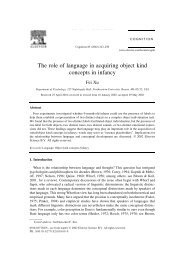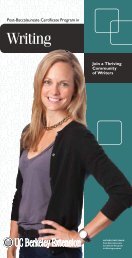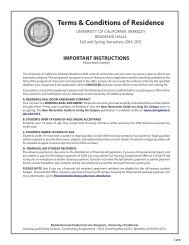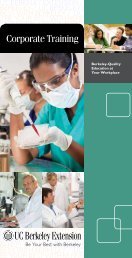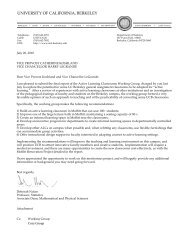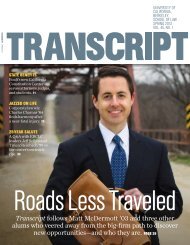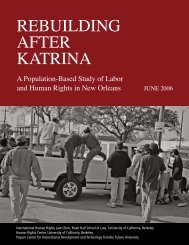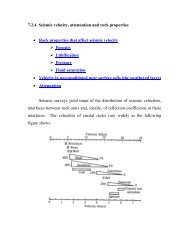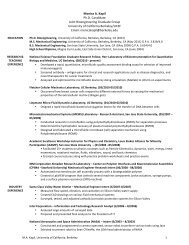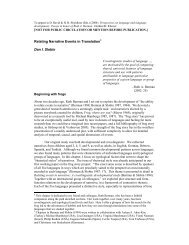LERA - UC Berkeley Labor Center
LERA - UC Berkeley Labor Center
LERA - UC Berkeley Labor Center
Create successful ePaper yourself
Turn your PDF publications into a flip-book with our unique Google optimized e-Paper software.
Proceedings of the<br />
61 st Annual Meeting<br />
January 3-5, 2009<br />
San Francisco, California
X. San Francisco and the New Social Compact<br />
San Francisco Values: The New Social Compact<br />
KEN JACOBS<br />
<strong>UC</strong> <strong>Berkeley</strong> <strong>Center</strong> for <strong>Labor</strong> Research and Education<br />
Abstract<br />
Over the last 12 years there has been a significant transformation of basic labor<br />
standards in San Francisco. A series of city policies have raised wages and expanded health<br />
care access and paid sick leave for ten of thousands of San Francisco workers. The earliest of<br />
these policies set minimum labor standards for firms doing business with the City and<br />
County of San Francisco. A second set of policies covered all firms operating within the<br />
geographical boundaries of the city. Over the same period, the city established new programs<br />
requiring card-check procedures at hotels and restaurants where the city has a proprietary<br />
interest, established a local earned income tax credit, and created a universal health access<br />
program for local residents. While modest by European standards, these policies represent a<br />
bold experiment in American industrial relations that can provide important lessons for the<br />
rest of the country.<br />
Introduction<br />
The move to enact labor standards policies on a local level emerged in the context of eroding federal<br />
protections. Over the course of the 1980s the real value of the minimum wage declined by 30% (Reich and<br />
Laitinen 2003). In 2000, 14.9% of workers nationally were covered by a union contract, a drop of 42% over<br />
two decades (Hirsch and McPherson 2008). In 1994 the first modern living wage law was passed in<br />
Baltimore. The law required service companies contracting with the city to meet wage standards above the<br />
federal minimum wage. Ten years later, more than 100 local jurisdictions had passed living wage laws (Fairris<br />
and Reich 2005). Over the course of the decade, these laws became more complex, applying to wider ranges<br />
of workers and containing a broader mix of protections, including minimum paid time off, requirements that<br />
workers be retained if the city contract changes hands, and protections against retaliation by employers<br />
against workers who file complaints.<br />
Over the course of the 1990s, San Francisco underwent an economic boom and a population shift as<br />
housing prices rose and middle income families left for surrounding areas. In 1989, the median income in San<br />
Francisco was slightly below the state median; 10 years later it was significantly higher. San Francisco’s growth<br />
in high-wage professional jobs during this period was accompanied by a growth in low-wage service jobs. By<br />
1999 San Francisco had a disproportionate number of families earning over $75,000 a year and under $10,000<br />
a year compared to the rest of the state (Reich and Laitinen 2003).<br />
Growing housing costs increased pressures on working families. Median home prices in San<br />
Francisco went from $175,000 to $540,000 in 2002. That same year, the California Budget Project estimated<br />
that a full-time single worker would need to earn $9.86 an hour to meet basic needs in San Francisco; for a<br />
single parent with one child they put the figure at $20.89 (Reich and Laitinen 2003).<br />
San Francisco was especially well suited to enact broad ranging labor standards laws that might be<br />
more difficult to achieve elsewhere in the state or country. San Francisco is located on the end of a peninsula.<br />
Its most important industry is tourism, which is location based. By 2000, San Francisco’s garment industry<br />
Author’s address: 2521 Channing Way, <strong>Berkeley</strong>, CA 94720<br />
180
SAN FRANCISCO & THE NEW SOCIAL COMPACT 181<br />
was largely gone, and the city had very few low-wage jobs in industries that are subject to strong out-of-town<br />
competition (Wells 2002).<br />
San Francisco is a strong labor town, with a rich tradition of community organizing. As a city and a<br />
county, San Francisco shares the legal powers of the two levels of government. This both broadens the reach<br />
of specific laws and allows for the passage of laws with a single act, where coordination of multiple<br />
jurisdictions would be required elsewhere. Unlike other counties that include suburban and rural areas that<br />
often have more conservative electorates, San Francisco is entirely urban. Starting in 2000, the San Francisco<br />
Board of Supervisors has been elected through district elections. This served to disperse power and increase<br />
the influence of labor, community organizations, and the city’s many democratic clubs.<br />
Equal Benefits for Domestic Partners: A Blueprint for Local Action<br />
In November 1996, the San Francisco Board of Supervisors enacted an equal benefits ordinance<br />
requiring firms that did business with the City and County of San Francisco to provide the same benefits to<br />
employees’ domestic partners that they provide to married spouses. The law applied to all firms entering into<br />
contracts or leases of more than $5,000 with the city. Benefits were defined broadly as including health<br />
insurance, retirement plans, leaves of absence, use of company facilities, and employee discounts.<br />
United Airlines, Federal Express, and the Air Transport Association sued, arguing preemption under<br />
federal law, including the Employer Retirement Income Security Act (ERISA), and violation of the<br />
Commerce Clause of the U.S. Constitution. The Federal District Court upheld the ordinance, with several<br />
important restrictions. Outside of the city or land owned by the city, the ordinance could only be applied<br />
where work related to a city contract is being performed. Where the city is acting as a regulator, rather than in<br />
its proprietary interest as a consumer, the ordinance could apply only to benefits not covered under ERISA,<br />
such as bereavement leave, paid family leave, and company discounts. An appeal by the employers was<br />
rejected by the 9th Circuit Court of Appeals (Air Transport Ass’n of America v. City & County of San Francisco).<br />
While the law was fundamentally a human rights ordinance, it did serve to broaden health coverage.<br />
Many contractors chose to extend the same rules to their entire workforce, not only to those covered by the<br />
law. A report by the San Francisco Human Rights Commission in 2002 estimated that more than 50,000<br />
people in 35 states had taken advantage of health insurance offered to domestic partners by firms contracting<br />
with the city (Goldstein 2002).<br />
With the Equal Benefits Ordinance, San Francisco directly established labor standards conditions on<br />
a wide range of firms, and did so in a way that survived legal challenge. The law served as a blueprint for<br />
many of the labor standards policies passed in San Francisco in the succeeding years. It also served as a model<br />
for other cities around the country.<br />
Card Check<br />
The next major piece of labor standards legislation came in December 1997, when the San Francisco<br />
Board of Supervisors passed the Employee Signature Authorization Ordinance. The ordinance requires that<br />
employers in hotel or restaurant developments where the city has a propriety interest as a landlord, lender, or<br />
loan guarantor enter into a card check agreement with a labor organization requesting such an agreement.<br />
The agreement must provide for a card check procedure with a neutral third party, binding arbitration over<br />
disputes, a prohibition on economic action by the union against the employer at worksites covered by the<br />
agreement as long as the employer is in compliance, and a prohibition on coercion or intimidations of<br />
workers by the labor organization or employer during the process (Wells 2002).<br />
The stated purpose of the ordinance is to protect the city’s economic interest from the threat of<br />
labor–management conflict where it is acting as a market participant, with the same risks and liabilities as<br />
others participating in similar ventures. It is expressly not intended to affect the outcome of the<br />
determination of preference regarding unionization.<br />
Since its inception, slightly more than 1,000 workers have chosen union representation through<br />
UNITE HERE! Local 2 using the Employee Signature Authorization Ordinance. During the same period, an<br />
additional 2,000 workers have gained union representation with Local 2 in San Francisco through card check<br />
neutrality agreements with hotels not covered by the ordinance (Lewis 2009).
182 <strong>LERA</strong> 61ST ANNUAL PROCEEDINGS<br />
Compensation Conditions on Public Contracts and Leases<br />
San Francisco was a relative latecomer in passing a living wage law. <strong>Labor</strong> and community<br />
organizations and policymakers drew from the experiences of other cities in crafting the San Francisco laws.<br />
At the same time, they introduced their own innovations and used San Francisco’s power as both a city and a<br />
county to reach greater numbers of workers. Between 1998 and 2001, a series of policies placing conditions<br />
on firms doing business with the city were passed by the San Francisco Airport Commission, the Board of<br />
Supervisors, and the Redevelopment Commission.<br />
In 1998 the city passed a law requiring janitorial firms contracting with the city to pay prevailing wage<br />
rates, including the cost of benefits. In 1999 the city passed the Displaced Worker Protection Act, which<br />
requires janitorial and security firms taking over contracts with the city to retain workers hired by the previous<br />
contractor for a transition period of at least 90 days.<br />
Quality Standards Program<br />
In January 2000, the San Francisco Airport Commission passed the Quality Standards Program,<br />
which was designed to improve safety and security at the San Francisco International Airport. At the time, the<br />
turnover rate for airport security screeners at SFO was nearly 100% a year (Reich, Hall, and Jacobs 2005).<br />
Officials at SFO expressed concerns over the impact of the high turnover rates on worker performance and<br />
airport security.<br />
With many security and airline service jobs carried out by airline contractors, the airport had no<br />
direct relationship with—or oversight over—many of the firms operating at the airport. The airport crafted<br />
an innovative policy designed to give it greater oversight of airline contractors and to address the high<br />
turnover rates. The Quality Standards Program established a permitting process for airline contractors<br />
operating in secure areas of the airport or carrying out security functions; minimum training and<br />
compensation standards were required as a condition for receiving a permit. The policy went into effect<br />
starting in April 2000. Nearly a third of the airport’s 30,000 workers received pay increases in the year<br />
following the implementation of the ordinance (Reich, Hall, and Jacobs 2005). As of January 1, 2009, the<br />
minimum compensation rate under the program at SFO was $12.33 an hour for firms that provide health<br />
coverage and $13.58 for those that do not.<br />
Minimum Compensation Ordinance<br />
In August 2000, the San Francisco Board of Supervisors passed an ordinance establishing living wage<br />
standards for firms contracting with the City and County of San Francisco or holding leases at the San<br />
Francisco International Airport. An additional 22,000 people not effected by the Quality Standards Program<br />
are projected to have benefited from the law, including 15,400 In-Home Supportive Services (IHSS) workers<br />
(Reich, Hall, and Hsu 1999; Reich and Hall 1999). The wage is indexed to the Bay Area Consumer Price<br />
Index. As of January 1, 2009, the required rate was $11.54 an hour, $11.03 for non-profit organizations<br />
(including IHSS).<br />
Healthcare Accountability Ordinance<br />
In 2001, companion legislation to the living wage ordinance was passed by the Board of Supervisors<br />
requiring firms with city contracts or leases to provide health insurance or pay $1.50 an hour per worker to<br />
the San Francisco Department of Public Health to cover the costs of the uninsured in the city. In 2006, the<br />
hourly requirement was raised to $2. While limited to firms doing business with the city, the Healthcare<br />
Accountability Ordinance could be considered the first pay-or-play health care policy to go into effect in the<br />
United States. In 2008, Governor Bill Richardson enacted a similar policy by executive order for state<br />
contractors in New Mexico.<br />
Sweat-Free Contracting<br />
In 2006 the Board of Supervisors passed an ordinance modeled on a similar law in Los Angeles,<br />
prohibiting the purchase of goods made under sweatshop conditions, using child labor or forced labor.<br />
Sweatshop conditions are defined as compensation under $10.15 an hour, including the cost of benefits. The
SAN FRANCISCO & THE NEW SOCIAL COMPACT 183<br />
minimum wage rate is adjusted nationally and internationally using purchasing power parity. The ordinance<br />
applies to good contracts over $25,000 and with duration of more than three months. The initial application<br />
of the law was focused on the purchase or rental of uniforms.<br />
Citywide Policies<br />
San Francisco’s living wage policies were largely variations on policies being carried out in other<br />
cities. They differed mainly in the number of workers covered. San Francisco was able to reach more workers<br />
through these policies in part as a result of its joint powers as a city and a county. San Francisco policy could<br />
reach the airport, the thousands of homecare and human service workers (a county function), and city service<br />
contractors. Where San Francisco has made the greatest innovation is in setting policies that apply to all<br />
employers in the city.<br />
Minimum Wage<br />
Building on the success of the living wage campaign, an initiative to create a citywide minimum wage<br />
was placed on the ballot by a coalition of labor and community organizations in November 2003. The<br />
initiative passed with 60% of the popular vote. It was the first minimum wage law implemented in a major<br />
city (not including Washington, DC; Reich, Dube, and Vickery 2005). At the time of passage, the minimum<br />
wage was predicted to impact 54,000 workers, 11% of the city’s workforce. This includes worker who were<br />
earning under the minimum wage rate and would received a mandated increase and those earning slightly<br />
above the minimum wage, where employers were expected to raise wages to retain employees (Dube, Naidu,<br />
and Reich 2006). The San Francisco wage was set at $8.50 an hour and indexed to the Bay Area Consumer<br />
Price Index. The current wage rate is $9.79, the second highest in the nation (Selna 2008).<br />
Working Families Credit<br />
Established as a pilot program in 2005, the Working Families Credit was designed to encourage takeup<br />
of the earned income tax credit (EITC), promote savings, and help working families stay in San Francisco.<br />
Initially funded with public and private sources, the program provided a 10% supplement to the EITC. In<br />
2005, 10,000 families received an average credit of $220. When private funding ran out at the end of the pilot<br />
program, the city switched to a flat credit of $100 per family. When families apply for the credit, they are also<br />
connected to other programs for low-income working families (Flacke and Wortheim 2006).<br />
Healthcare Security<br />
In October 2003 the California legislature passed SB2, a pay-or-play health care law sponsored by<br />
state senator John Burton with the support of the California <strong>Labor</strong> Federation, the California Medical<br />
Association, Kaiser Permanente, and Blue Shield of California, among others. The bill was signed into law by<br />
then-governor Gray Davis shortly before he was recalled. A referendum effort led by the California Chamber<br />
of Commerce forced the law onto the ballot in November 2004, where it was defeated by a slim margin.<br />
While the referendum lost statewide, it passed with 69% of the vote in San Francisco. Supervisor<br />
Tom Ammiano and the San Francisco <strong>Labor</strong> Council began a discussion over how similar legislation could be<br />
enacted at a local level. At the time, an estimated 82,000 San Franciscans lacked health coverage; 56% were<br />
employed. The city was spending $104 million a year on health services for the uninsured (Universal<br />
Healthcare Council 2006). Supervisor Ammiano introduced the initial legislation in late 2005. In February<br />
2006, Mayor Gavin Newsom requested that the supervisors hold off on voting on the legislation, while he<br />
convened a universal healthcare council made up of healthcare providers, labor, business, and other<br />
community stakeholders charged with developing a proposal for universal healthcare in San Francisco. The<br />
council proposed a universal health access program and left decisions on financing the program to the Board<br />
of Supervisors. The San Francisco Healthcare Security Ordinance was approved in July.<br />
The resulting ordinance has two central elements: it establishes a new health program, Healthy San<br />
Francisco, to provide comprehensive health services to uninsured San Francisco residents with a focus on<br />
prevention, and it sets a minimum health spending requirement for firms with 20 or more workers.<br />
Employers may meet the requirement through contributions toward health benefits, health savings accounts,
184 <strong>LERA</strong> 61ST ANNUAL PROCEEDINGS<br />
direct reimbursement of health care costs, or payment into the city program. The requirement was designed<br />
to level the playing field for firms that already provide coverage, discourage firms from dropping coverage<br />
and placing a greater burden on the new public program, and help reduce the taxpayer cost of caring for<br />
uninsured workers. The public plan creates an affordable option for employers that do not currently provide<br />
health coverage to all or part of their workforce.<br />
Healthy San Francisco, operated by the San Francisco Department of Public Health, is open to<br />
uninsured San Francisco residents regardless of health, employment, or immigration status on a sliding scale<br />
based on income. Enrollees are assigned a medical home and a primary care physician through one of the<br />
city’s public or nonprofit clinics. Acute care and specialty care are provided by San Francisco General and a<br />
network of the city’s nonprofit hospitals. Prescription drugs are provided with co-pay. Healthy San Francisco<br />
is a health access program, not insurance. Health services are not available through the program outside of<br />
the local network. The program is funded by the public, individuals, and employers. It also receives in-kind<br />
contributions from nonprofit hospitals.<br />
Businesses with 20 to 99 workers are required to spend a minimum of $1.23 an hour per employee<br />
on health services. For a full-time employee, this is equivalent to 50% of the average amount that the 10<br />
largest counties in California (other than San Francisco) spend on individual health coverage for their<br />
employees. Businesses with 100 or more workers are required to spend a minimum of $1.85 an hour per<br />
employee on health services. For a full-time employee, this is equivalent to 75% of the average amount that<br />
the 10 largest counties in California (other than San Francisco) spend on individual health coverage for their<br />
employees. Workers of firms who pay into the program receive a 75% discount on enrollment fees. There is<br />
currently no enrollment fee for any worker with a household income of less than 300% of the federal poverty<br />
level whose employer pays into the program.<br />
Nearly half of those who work in San Francisco do not live in the city and are thus not eligible for<br />
Healthy San Francisco, which is available only to San Francisco residents. Focus groups of employers found<br />
strong reluctance to elect to pay into the city program if the business could do so only for part of their<br />
workforce and would need to find another option for workers living outside of the city. To resolve this<br />
problem, the Department of Public Health proposed to use the funds paid on workers who do not live in the<br />
city to established medical reimbursement accounts in their names. The ordinance was amended by the Board<br />
of Supervisors accordingly.<br />
The Golden Gate Restaurant Association immediately sought an injunction against the employer<br />
minimum health spending requirement on the grounds of ERISA preemption. Under ERISA, state and local<br />
governments may not impose mandates with respect to health and retirement plans covered under the act. In<br />
January 2007 the 4th Circuit Court upheld a District Court ruling overturning a Maryland law requiring very<br />
large employers (WalMart) that did not spend at least 8% of payroll on health services to pay a fee to the state<br />
to cover the cost of health care for the uninsured. In the Maryland ruling, the court found that since the<br />
workers received no benefit if the employer chose to pay in, no rational employer would choose to do so;<br />
therefore the law effectively forced employers to alter their existing ERISA plans (RILA v. Fielder).<br />
On December 26, 2007, the District Court granted the injunction. The city immediately appealed for<br />
a stay along with the San Francisco <strong>Labor</strong> Council, the Service Employees International Union Local 1021,<br />
SEIU United Health Care Workers West, and UNITE HERE Local 2. On January 9th, 2008, a three-judge<br />
panel from the 9th Circuit Court of Appeals granted the stay and allowed the law to go into effect. In<br />
September 2008, the panel ruled in favor of the city.<br />
The core of the case rotates around the question of whether employers have a means of compliance<br />
that leaves their ERISA plans “intact and unaltered.” The panel agreed with the city that by including the<br />
public option, employers have a rational means of compliance with the law that does not involve an ERISA<br />
plan. They also rejected the argument that the city’s health access plan is itself an ERISA plan, since it<br />
receives funds from employers. The panel noted that the plan is available to low- and moderate-income San<br />
Franciscans without regard to employment status and that it is primarily funded by taxpayers (Golden Gate<br />
Restaurant Ass’n v. City and County of San Francisco 2008). The restaurant association has sought review by the<br />
full 9th Circuit Court and the request for review is pending.<br />
The employer-spending requirement went into effect on April 17, 2008, for employers with 50 or<br />
more workers and April 1, 2009, for employers with 20 to 49 employees. Nearly 1,000 employers had chosen
SAN FRANCISCO & THE NEW SOCIAL COMPACT 185<br />
to pay into the city plan by the end of August 2008, contributing $17.5 million on behalf of 26,000 workers.<br />
Half the workers were eligible for Healthy San Francisco; the other half received Medical Reimbursement<br />
Accounts. Close to 30,000 individuals had enrolled in the program; the Department of Public Health projects<br />
that the number will grow to 60,000 by the end of 2009 (Healthy San Francisco Update 2008).<br />
Paid Sick Leave<br />
In November 2006, San Francisco became the first city in the country to require employers to<br />
provide paid sick leave when a ballot initiative establishing the policy passed with 61% of the vote. The law<br />
requires employers to provide one hour of paid sick time for every 30 hours worked. Workers for businesses<br />
with fewer than 10 employees may accrue at least a minimum of 40 hours of paid sick time; for all other<br />
businesses the minimum required accrual is 72 hours. Employees may use the time for their own health care<br />
or to care for a family member who is sick. Implementation of the ordinance was postponed until June 5,<br />
2007, by the Board of Supervisors to give employers time to come into compliance.<br />
Enforcement<br />
In 2000 San Francisco established an Office of <strong>Labor</strong> Standards Enforcement (OLSE) to oversee<br />
enforcement of the city’s prevailing wage laws for construction and living wage law. The office has since been<br />
expanded and given enforcement responsibilities over many of the laws discussed in this paper. Among its<br />
duties the OLSE proposes regulations, sends out notifications to employers about changes in the laws,<br />
investigates worker complaints, and conducts audits of city contractors. The city also contracts with a group<br />
of local community-based organizations to educate workers about their rights under the laws. This includes<br />
organizations working in the Chinese and Latino communities, where language can be a barrier to<br />
enforcement.<br />
Discussion<br />
San Francisco’s new labor standards policies have brought meaningful improvements in<br />
compensation and access to healthcare to thousands of low-wage workers and their families in the city. The<br />
combination of three citywide policies together creates an effective minimum compensation level—including<br />
the minimum wage, the cost of paid time off and minimum health spending contributions—of $10.12 to<br />
12.03 an hour, depending on the size of the firm. These numbers should be placed in the context of the San<br />
Francisco economy. In 2007, the nonprofit California Budget Project (2007) estimated the minimum hourly<br />
amount needed for a full-time working single adult to meet basic expenses in San Francisco at $14.25 an<br />
hour.<br />
The research to date on the impacts of the San Francisco minimum wage and living wage policies has<br />
found no measurable effects on employment levels. Dube, Naidu, and Reich (2006) surveyed restaurants in<br />
San Francisco and surrounding areas before and nine months after implementation of the ordinance. They<br />
found a small but not statistically significant increase in employment in affected restaurants compared to the<br />
control group. The length of employee tenure increased in limited service restaurants by an average of 3.5<br />
months, as did the share of employees working full-time. Restaurants in San Francisco raised prices 2.8%<br />
more than the control group during the same time period (Dube, Naidu, and Reich 2006). These results are<br />
similar to those found by Card and Kruger (1994) and in a national study by Dube, Lester, and Reich<br />
(forthcoming) estimating the impact of state minimum wage laws on continuous counties across state lines. A<br />
2008 study by the Chicago Federal Reserve Bank suggests that minimum wage laws may be an especially<br />
effective form of economic stimulus, since low-wage workers spend most of their earnings and spend them<br />
locally (Aaronson, Agarwal, and French 2008). Indexing the minimum wage, as was done in San Francisco,<br />
allows workers’ wages to keep up with the cost of living and avoids the larger wage shocks to employers that<br />
come from more intermittent adjustments (Ettlinger 2006).<br />
Research on the Quality Standards Program at SFO found that the program had a sharp and<br />
immediate impact on employee turnover and job performance. Reich, Hall, and Jacobs (2005) found that 15<br />
months after the policy went into effect turnover had fallen by a third among all firms and 60% among the<br />
firms with the greatest share of affected workers. Annual turnover of security screeners fell 80%. Sizeable
186 <strong>LERA</strong> 61ST ANNUAL PROCEEDINGS<br />
numbers of employers reported higher morale, fewer grievances, fewer absences, and better customer service.<br />
Employees reported that they worked harder, that more skills were required of them on the job, and that the<br />
pace of work had increased. The study found no impact on employment levels.<br />
The healthcare and paid sick leave policies are too new to fully measure their impact. From the<br />
evidence thus far, employers have largely opted to leave their current benefit programs intact, while paying<br />
into the city program for those workers who do not have health coverage. A number of restaurants have<br />
adapted to the ordinance by adding surcharges to the cost of dining, ranging from $1 an entrée to 5% of the<br />
bill. The Golden Gate Restaurant Association, which did not take a position on the paid sick leave initiative,<br />
reported that the leave requirement has not been a major issue for their members (Jackson 2008).<br />
Employers have raised concerns about large numbers of different jurisdictions creating conflicting<br />
standards on healthcare. San Francisco’s health reforms are not likely to have widespread adoption by other<br />
cities. San Francisco started from an exceptionally strong public health infrastructure that could be used as<br />
the core of the health network. The reforms relied on the city’s legal power to set a minimum health spending<br />
standard and on the public health system, which is operated by the county. San Mateo County to the south of<br />
San Francisco is contemplating a similar program. Like San Francisco, it has a strong public health<br />
infrastructure to build on. Unlike San Francisco, it would face the more difficult task of passing the same law<br />
in the county and a myriad of different cities. The San Francisco experience may be most relevant at the state<br />
and national level.<br />
San Francisco’s policies offer important lessons for the rest of the country. Healthcare reform with<br />
shared responsibility, paid sick leave, majority verification for union recognition, and a higher minimum wage<br />
indexed to inflation were all parts of Barack Obama’s platform during his presidential bid. We can expect<br />
debates on many of these issues over the coming years. San Francisco provides a useful case to study.<br />
References<br />
Aaronson, Daniel, Sumit Agarwal, and Eric French. 2008. The Spending and Debt Response to Minimum Wage<br />
Hikes. May 29. FRB of Chicago Working Paper No. 2007-23.<br />
Air Transport Ass’n of America v. City & County of San Francisco, 992 F.Supp. 1149 (N.D. Cal.1998).<br />
California Budget Project. Making Ends Meet: How Much Does it Cost to Raise a Family in California October<br />
2007.<br />
Dube, Arindrajit, Bill Lester and Michael Reich. Forthcoming. “Minimum Wage Effects Across State<br />
Borders: Estimates Using Contiguous Counties,” Review of Economics and Statistics.<br />
Dube, Arindrajit, Suresh Naidu, and Michael Reich. 2006. “The Economic Effects of a Citywide Minimum<br />
Wage,” Industrial and <strong>Labor</strong> Relations Review, Vol. 60, No. 4, pp. 522–43.<br />
Ettlinger, Michael. 2006. Securing the Wage Floor: Indexing Would Maintain the Minimum Wage’s Value and Provide<br />
Predictability to Employers. EPI Briefing Paper #177, October 12.<br />
Fairris, David, and Michael Reich. 2005. “The Impacts of Living Wage Policies: Introduction to the Special<br />
Issue.” Industrial Relations, Vol. 44, No. 1, pp. 1–13.<br />
Flacke, Tim, and Tina Wortheim. 2006. Delivering a Local EITC, Lessons from San Francisco’s Working Families<br />
Credit. The Brookings Institution Survey Series, May; City of San Francisco Working Families Credit<br />
.<br />
Golden Gate Restaurant Ass’n v. City and County of San Francisco, 546 F.3d 639 (9th Cir. 2008).<br />
Goldstein, Cynthia. 2002. Five Year Report On The San Francisco Equal Benefits Ordinance. San Francisco Human<br />
Rights Commission, November. .<br />
Healthy San Francisco Program Update. 2008. San Francisco Health Commission, August.<br />
Hirsch, Barry, and David McPherson. “U.S. Historical Tables: Union Membership, Coverage, Density and<br />
Employment, 1973-2007,” All Wage & Salary Workers. . [December<br />
29, 2008].<br />
Jackson, Derrick. 2008. “Sick-Leave Issue Connects with Every Worker.” Boston Globe, November 25.<br />
Lewis, Ian. 2008. UNITE HERE Local 2. Private communication, December 29.<br />
Reich, Michael, and Peter Hall. 1999. Living Wages at the Airport and Port of San Francisco: The Benefits and the<br />
Costs. San Francisco In-Home Social Services Public Authority 2007 annual report, October.
SAN FRANCISCO & THE NEW SOCIAL COMPACT 187<br />
Reich, Michael, and Amy Laitinen. 2003. Raising Low Pay in a High Income Economy: The Economics of a San<br />
Francisco Minimum Wage. Report for San Francisco Board of Supervisors, May.<br />
Reich, Michael, Arindrajit Dube, and Gina Vickery. 2005. Minimum Wages and the California Economy: The<br />
Economic Impact of AB 48. Institute for Research on <strong>Labor</strong> and Employment Policy Brief, September.<br />
Reich, Michael, Peter Hall, and Fiona Hsu. 1999. Living Wages and the San Francisco Economy: The Benefits and the<br />
Costs. <strong>UC</strong> <strong>Berkeley</strong> Institute of Industrial Relations, June.<br />
Reich, Michael, Peter Hall, and Ken Jacobs. 2005. “Living Wage Policies at the San Francisco Airport:<br />
Impacts on Workers and Businesses.” Industrial Relations, Vol. 44, No. 1, pp. 106–38.<br />
RILA v. Fielder, No. 06-1840 (4th Cir. Jan. 17, 2007).<br />
Selna, Robert. 2008. “SF Minimum Wage Raises to $9.79 in 2009.” San Francisco Chronicle, December 26.<br />
Universal Healthcare Council. 2006. San Francisco Health Access Program: Serving Uninsured Adults (Final Report<br />
to Mayor Gavin Newsom). June 23.<br />
Wells, M.J. 2002. “When Urban Policy Becomes <strong>Labor</strong> Policy: State Structures, Local Initiatives, and Union<br />
Representation at the Turn of the Century.” Theory and Society, Vol. 31, No. 1 (February), pp. 115–46.



